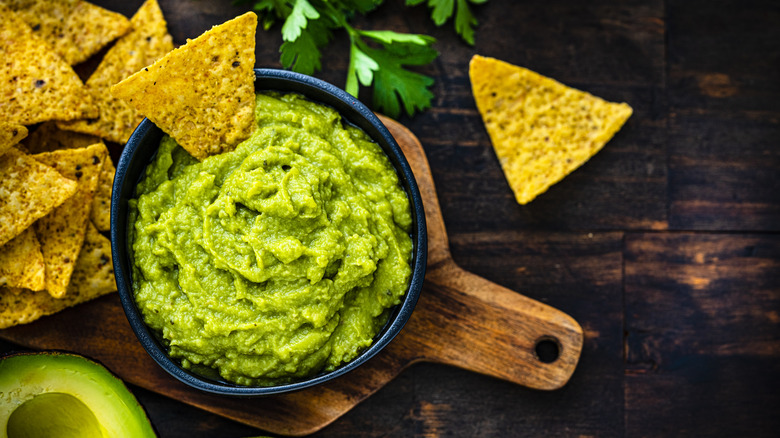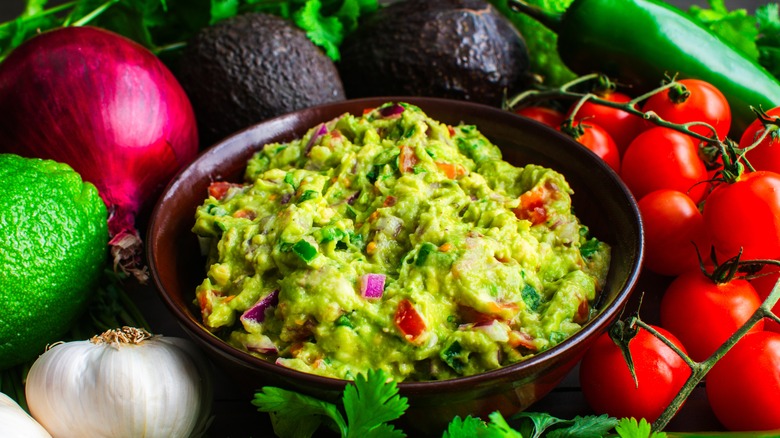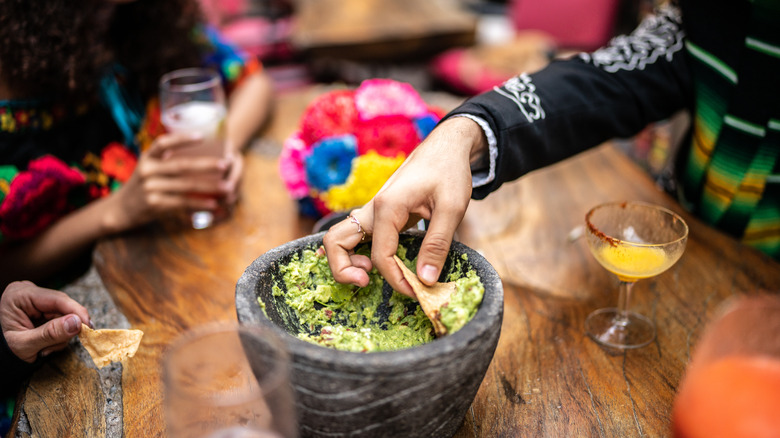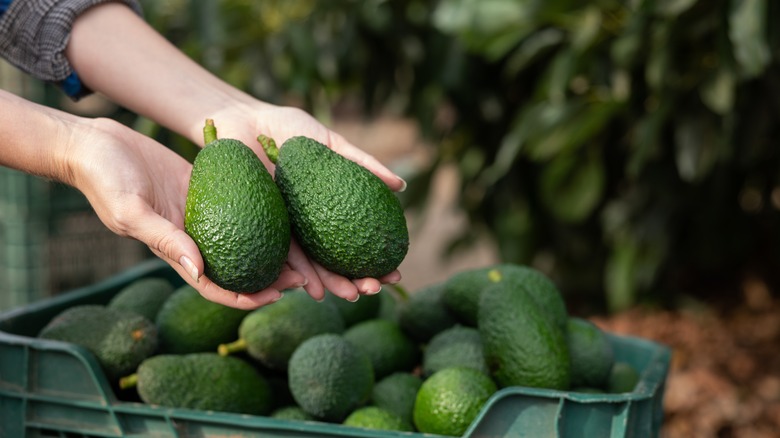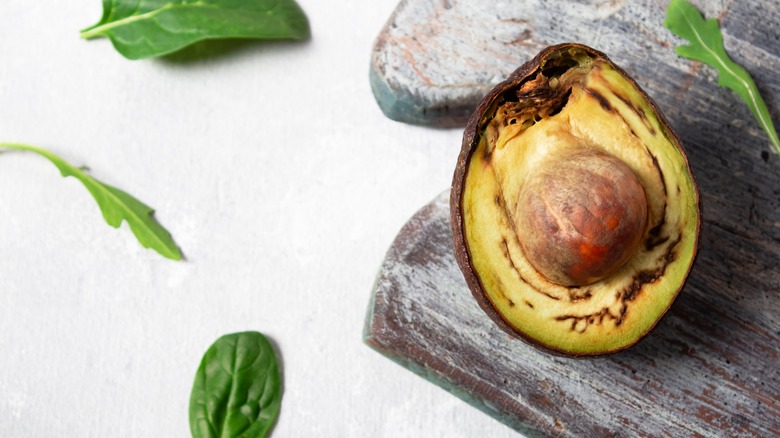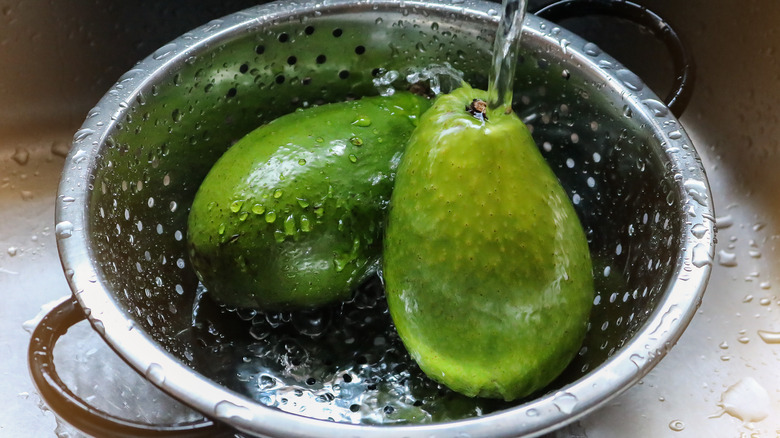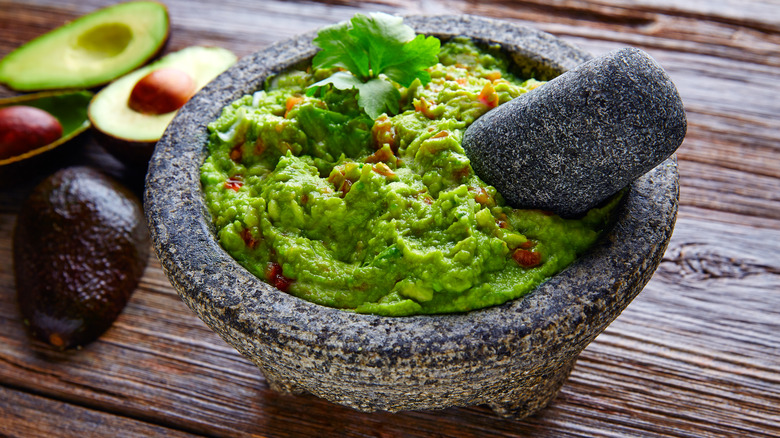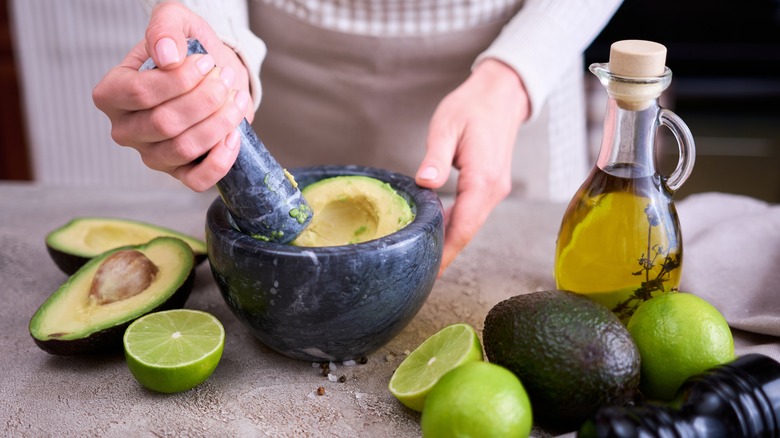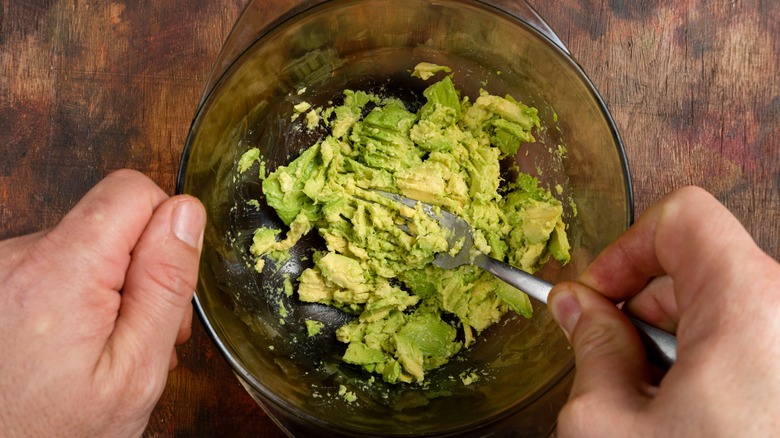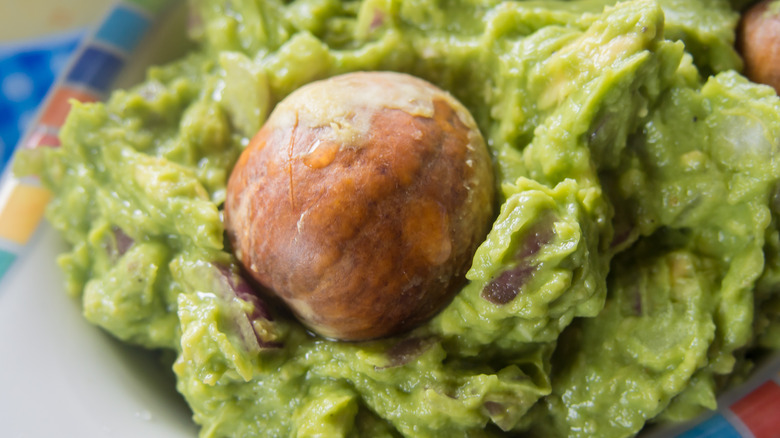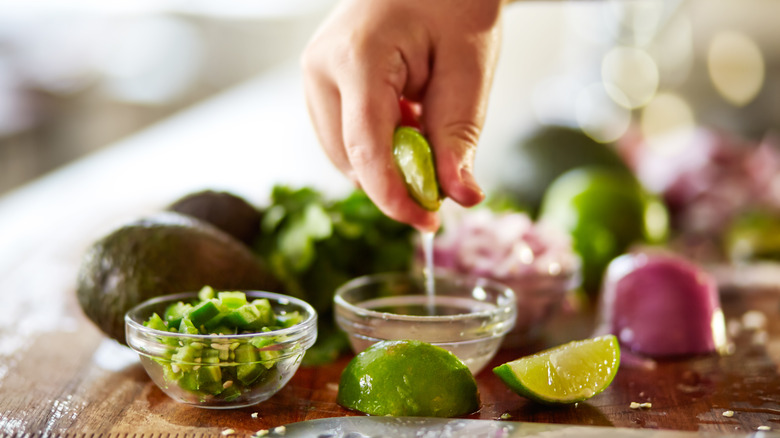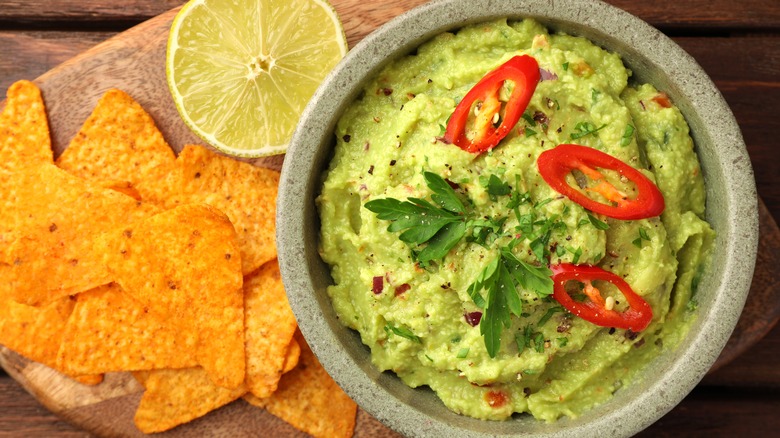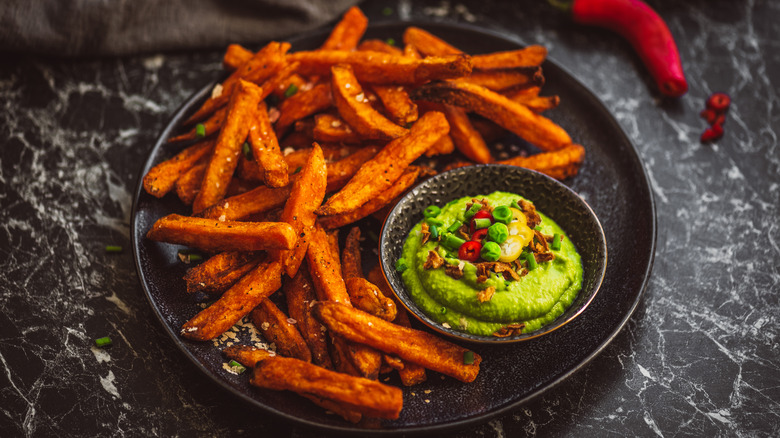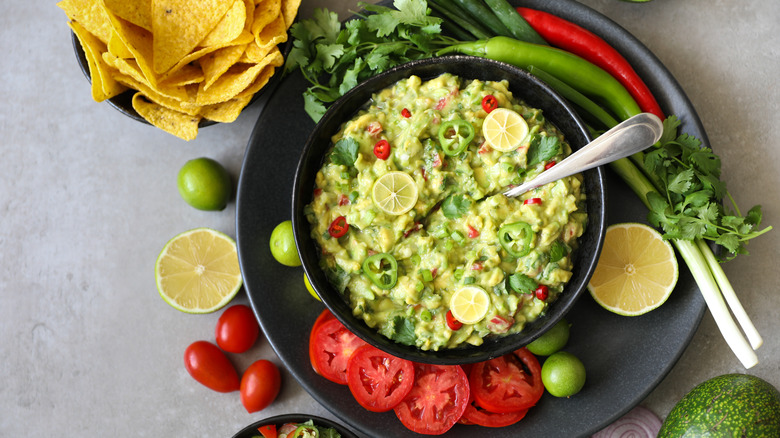Guacamole Myths You Should Stop Believing
Created centuries ago by the ancient Aztecs, guacamole is a beloved snack worldwide. It's easy to see why people love this creamy avocado dish. An easy guacamole recipe requires only a few ingredients and can be whipped up in under 10 minutes. Guacamole is also very versatile, with countless variations on the dish and multiple ways it can be served. It's no wonder then that it's a popular appetizer at so many restaurants, a staple at Super Bowl parties, and a go-to dish for home cooks.
At its essence, guacamole is pretty straightforward. It typically includes fresh, mashed avocados mixed with lime juice, tomatoes, onions, chiles, cilantro, and salt. Yet despite its simplicity, there are many myths floating around about the dish. For example, some people say there are genius hacks to make preparation faster and easier, while others will tell you there are strict rules you must follow to make authentic, restaurant-worthy guacamole. Some people claim to have the secret to preventing the avocados from going brown. Then there's the matter of whether guacamole is actually healthy. What's real and what's fiction? Not to worry because we're here to set the record straight.
Myth: Guacamole is a vegetable dish
With guacamole's vivid green color and zesty flavor, it's easy to see why so many people consider it a vegetable dish. A classic guacamole is indeed plant-based. However, one of the things that you may not know about avocados is that they're actually fruits. In fact, avocados were once called alligator pears thanks to their rough green skin and pear shape. That moniker went out of fashion thanks to avocado growers in America who lobbied to change the name because they thought it was unappealing.
So, what exactly is the difference between a fruit and a vegetable? Basically, fruits grow from flowering plants and contain one or more seeds. Vegetables are the other parts of plants that we eat, like leaves, tubers, or stems. Because avocados have seeds, they're considered fruits. Other "vegetables" that are actually fruits include tomatoes, bell peppers, pumpkins, and chiles. Given that your typical guacamole contains avocados, tomatoes, and chiles, you could consider it a fruit salad.
Myth: Guacamole is pronounced with a hard G
If you're like most Americans, you probably pronounce guacamole "GWA-ka-mow-lee" or something to that effect. You may even call the dish just "gwak." Head south of the border, though, and you'll find locals pronounce it differently. Many Spanish speakers use a soft "G" and emphasize the second-last syllable, so it sounds more like "wa-ka-MOH-lay." Some of this comes down to the different ways Spanish and English speakers pronounce certain letters and words. More so, though, it's rooted in the history of the dish and the etymology of the word.
Avocados are native to Mexico and parts of Central and South America, so it should come as no surprise that this is where guacamole was invented. The first reference to guacamole in literature comes in 1571, and it describes an Aztec dish made with avocados and peppers. The name comes from the Nahuatl words "ahuacatl" for avocado and "molli," which is a type of sauce or salsa. These words became "aguacate" and "mole" in Spanish. Over time, the words merged to become "ahuacamolli" in Nahuatl and guacamole in Spanish.
Myth: You can use any type of avocado for guacamole
One of the false facts many people believe about avocados is that there is only one type. In actuality, there are hundreds of varieties of this fruit grown around the world. There are three main groups of avocados: Guatemalan, Mexican, and Indian. Among these groups, you'll find avocados with names like Choquette, Bacon, Reed, and Zutano. The most common type of avocado found in the U.S. is Hass. The California Avocado Commission states that 95% of the state's total avocado crops are of the Hass variety.
It may be a good thing that Hass avocados are often the only variety available at many supermarkets because they have characteristics that make them perfect for guacamole. Underneath the rough, dark skin, they have creamy flesh that is rich in oil. That makes them easy to mash. They also impart a beautiful, velvety texture and nutty flavor. Another variety you may come across is the Florida avocado. While those tend to be bigger than Hass avocados, they contain less fat content, have more water, and produce a milder taste. You can use them for guacamole, but the end result won't be as rich and buttery.
Myth: It's okay if your avocados are under or over-ripe
One of the most frustrating things about avocados is they seem to go from rock hard to a pile of mush in the blink of an eye. That can make it difficult to gauge when to use them for guacamole. You may be tempted to get a jump start by using not-quite-ripe avocados, but you'll likely end up with rubbery guacamole. If you use overripe avocados, your guacamole may be an unappetizing brown color and taste slightly funky. For the ideal guacamole, you want avocados that are in their glorious, green prime.
One of the biggest mistakes people make with avocados is buying the wrong ones. The industry group Avocados From Mexico suggests choosing the fruits that are dark, bumpy, and slightly soft to the touch, but not overly mushy. If you can only find unripe avocados, try placing them in a paper bag with fruits that release ethylene gas like bananas or apples. The gas will help the avocados ripen quicker. If your avocados are already ripe but you need to hold off on making guacamole for a few days, place the avocados in the refrigerator. They should hold up in the fridge for about a week.
Myth: You don't need to wash your avocados before making guacamole
Avocados are one of those handy fruits that come in their own packaging. The tough skin protects the fruit inside until it's ready to eat, at which point most people scrape out the flesh and throw away the skins. Since you're not consuming the skin, you may think there's no need to wash the avocado. The truth is avocado skins can harbor harmful bacteria that can be transferred to the flesh when you cut into the fruit with a knife.
In 2014, the U.S. Food and Drug Administration did a study to test for the presence of Salmonella and Listeria monocytogenes on avocados. It found that less than 1% of the avocados tested positive for Salmonella and nearly 18% tested positive for Listeria monocytogenes on the skin. Therefore, the agency recommends washing avocados before cutting and consuming them. More recently, the FDA responded to a social media trend, explaining that submerging avocados in water to store them is not a good substitute for washing because the liquid storage can cause pathogens to multiply. The agency says the best way to prevent bacteria transfer is to scrub, rinse, and thoroughly dry all produce.
Myth: A food processor will give you the same results as a mortar and pestle
The internet is rife with guacamole hacks to help you make the perfect version of the dish. One hack that many people suggest is using a food processor to whiz up all your ingredients and cut back on your prep time. While this method certainly is quick and easy, it's not going to result in the greatest-tasting guacamole. There's a reason so many cooks on both sides of the border insist on using a mortar and pestle, or a molcajete as it's called in Mexico.
As chef and food journalist J. Kenji López-Alt explains in a YouTube video, "There is a huge, huge difference between guacamole that's made in a molcajete versus a guacamole that's made with hand-chopped ingredients or even ingredients in a food processor." He goes on to explain that when you grind the onions, cilantro, chiles, and salt using a mortar and pestle, you break the cells to release more juices and flavors. Another reason a molcajete is superior to a food processor is it gives you more control over the consistency, so you can make your guacamole as chunky or as smooth as you like.
Myth: You should mash all the ingredients together at the same time
How do you prepare your guacamole? Many people chop up their ingredients on a cutting board, then throw everything in a bowl and mash it all together. Others break down the avocado first, then fold in the other ingredients. You might be surprised to hear that the order in which you add the ingredients can affect how your guacamole turns out. In fact, many chefs will tell you that mashing everything at the same time is one of the biggest mistakes people make with guacamole.
Once again, chef J. Kenji López-Alt has some expert insight. In his YouTube video, he recommends starting with aromatics like onions, cilantro, and chiles in a molcajete with some salt to release all the flavor compounds. Then you can mash your avocados into the mix and fold in wetter elements like lime or lemon juice. Tomatoes can work, too! The key is to allow all the flavors to meld together evenly so that every bite gives you a range of flavors that complement each other.
Myth: There's no limit to how much you can mash your avocados
There's a common misconception that you need to pulverize your avocados to make an ultra-satisfying guacamole. That's not entirely accurate. Of course, people have different tastes when it comes to how chunky or smooth they like their guacamole. There are some issues that can arise when you smash your avocados into oblivion though. First, it can make the guacamole too runny or gloopy. Too much mashing also adds air to the guacamole, which can make it turn brown faster.
Chef Geoffrey Zakarian's tip for great guacamole is to leave a few lumps in the mix to add textural contrast and visual appeal. The lumps will also make it easier to scoop the guacamole up. Zakarian suggests using a large fork to gently mash the avocados. Another kitchen tool you can use to mash avocados is a whisk. Larger models like French whisks have thin, spaced-out wires that can cut through the avocado while leaving larger chunks in place. The result is guacamole that has a great balance of creaminess and chunkiness.
Myth: Placing the avocado pit in the guacamole will prevent it from turning brown
Is there anything worse than guacamole that's turned a putrid-looking grayish-brown? One thing you should know about brown guacamole is that it's perfectly safe to eat (your homemade guacamole will stay fresh in the refrigerator for two to three days). However, it sure is unappetizing to look at. Avocados turn brown thanks to an enzyme called polyphenol oxidase. When the avocado is cut open and the cells in the flesh are damaged, oxygen causes a chemical reaction with the enzyme that turns the flesh brown. One method that many people swear by to prevent this from happening is placing an avocado pit in the guacamole.
Unfortunately, the "pit-in-the-dip" method doesn't do much and may in fact aid in browning. The only way to prevent oxidation is to limit the amount of oxygen that hits the cut avocados. The avocado pit may protect the surface of the guacamole it directly touches, but nothing else. Plus, if you place plastic wrap over the dip with the pit in it, the pit can create air pockets. Therefore, you're much better off sealing the surface of the guacamole tightly with plastic wrap. Some people also add water or lime on top of the guacamole before adding the plastic wrap to create another barrier.
Myth: Traditional guacamole must be made with lime juice
Search for guacamole recipes, and you'll probably find that most of them call for lime juice. It adds a citrusy kick to the mild flavors of the avocado and pairs well with other traditional Mexican ingredients like chiles and cilantro. But is it authentic? Many chefs would say no. Some point to the fact that the ancient Aztecs used only avocados, chiles, and sometimes tomatoes. It was the Spaniards who introduced other ingredients like cilantro, onions, and lime to guacamole recipes. Some purists also say the lime overpowers the taste of the avocado.
The truth is there is no definitive way to make guacamole other than it must contain avocados. You can add the lime or leave it out if you prefer. The same goes for other ingredients. You can make guacamole without cilantro if you're not a fan of the herb. You can also add other ingredients to jazz up your guacamole if you like. Chef and TV host Guy Fieri makes a mean guacamole with chorizo. Other popular add-ins include queso fresco, corn, and mayo. Just try not to overload the guacamole with too many add-ins because then you'll really lose the avocado flavor.
Myth: You don't need to season guacamole
Have you ever wondered why guacamole seems to taste so much better at a restaurant than at home? The answer may be in the seasoning. Restaurant chefs season liberally when it comes to most dishes, and guacamole is no exception. Avocados tend to be very mild, so they can benefit from a boost of seasoning like fresh herbs or chiles. In addition, they're high in monounsaturated fats, which gives them their richness. Salt and an acid like lime or lemon juice will help cut through the fat and bring out the freshness and flavor.
The key to perfectly seasoned guacamole is to start off with just a bit of seasoning and taste test as you go. Remember that you can always add more seasoning, but it's hard to take things back if you add too much. If plain old salt, lime, and chiles aren't doing it for you, consider branching out. You could add cumin or chipotle powder for some smokiness, garlic for some zing, or black pepper for an extra hit of heat. Don't be afraid to get creative with your seasonings.
Myth: Guacamole must be served with tortilla chips
There's no doubt that guacamole pairs perfectly with tortilla chips. The sturdiness of the chips can withstand the chunkiness of the guacamole and adds a hit of saltiness that cuts through the richness of the dip. Plus, the toasty flavor of the corn adds an earthiness to the fresh avocados. But who's to say tortilla chips are the only accompaniment that can grace a bowl of guac?
The sky is the limit when it comes to foods you can serve with guacamole. For a healthier option, consider fresh veggies like carrots, celery, or sliced peppers. Or you can try cooked shrimp, pretzels, or root vegetable chips. You can also dunk fries into your guacamole or use crostini as a vehicle for the dip. Guacamole can also be so much more than just a dip. You can use it as a spread for sandwiches, a sauce for tacos, or a topping for toast. You can also add a dollop of guacamole to a salad or rice bowl.
Myth: Guacamole is unhealthy
One of the biggest debates about guacamole is whether it's good for you. Many detractors point to the fact that avocados are high in fat. That is true. However, avocados contain monounsaturated fats, which are considered healthy fats. According to MedLinePlus, these types of fats can lower your LDL cholesterol (that's the bad kind) and help with healthy cell growth. Avocados also contain plenty of fiber, antioxidants, and nutrients like potassium and folate.
Another thing people bring up in the debate over whether guacamole is healthy or not is that the dip can be high in calories and sodium. That really depends on the recipe. Guacamole on its own is often less calorie-heavy than other dips that contain mayo or sour cream. In addition, guacamole contains fiber, so it fills you up faster. What really amps up the calories and salt intake are the tortilla chips. If you want to lighten up your guacamole, consider cutting out the chips and replacing them with veggies.
